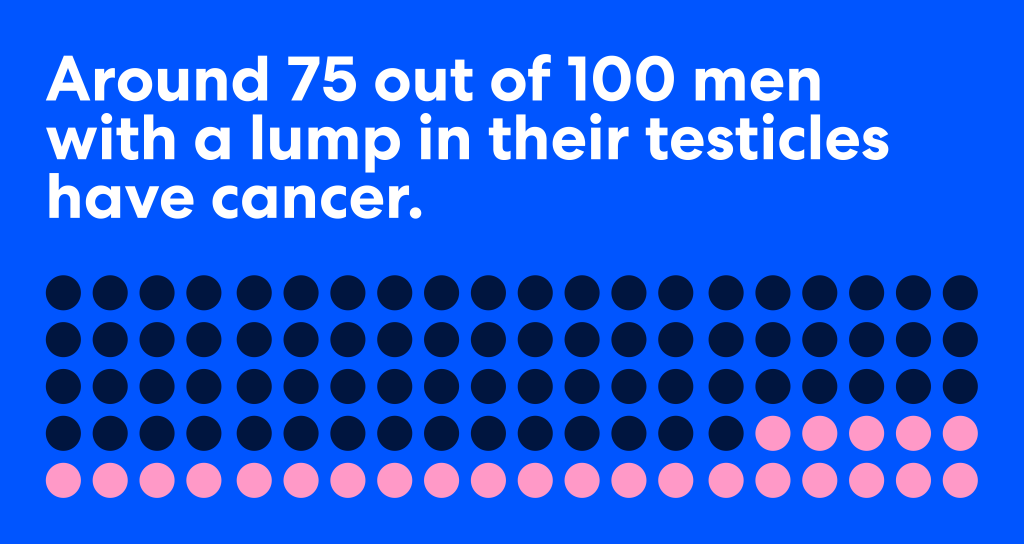This article has been medically reviewed by Dr Varun B R, MBBS, MD (Internal Medicine), MRCP (UK), CCEBDM.
I’ve been told to always open with a joke but I say nuts to that! 🌚
On that note, allow me to tell you that conversations about diseases and illnesses can often get grim. But as a healthcare company, it is our duty and KRA to make difficult topics fun and intelligible. So, let’s dive in and talk about testicular cancer in the easiest language you can find on the internet.
“First up, what is Testicular cancer?”
Testicular cancer is a type of cancer that originates in the testicle(s). Testicles are reproductive glands responsible for producing sperm and hormones in males. Testicular cancer is mainly diagnosed in males between the age of 15-40. Though a rare one, testicular cancer can be a painful and trying ordeal if it’s not detected and treated in time.
“A little more biology, please?“
Testicular cancer often begins in the germ cells, the cells responsible for making sperm. Germ cell tumour is also the most common type of testicular cancer.
Mainly, there are two types of Germ Cell Tumours:
Seminomas
It’s the kind that grows slowly, is confined to just testicles and is responsive to radiation therapy and treatments.
Non-seminomas
It’s the more common type of cancer that is fast-growing and can spread to other organs.
Scary words aside, testicular cancer is easily treatable and curable.

But we still recommend familiarising yourself with the signs & symptoms to get ahead of it.
“Alright, tell me about the symptoms“
Cancer is an unusual growth of cells, usually presenting itself as a small mass or cyst. Testicular cancer, unlike other cancers, can often be self-diagnosed. We’ll tell you how but before that, these are other evident signs of testicular cancer.
- An abnormal lump in your testes
- Pain or obvious discomfort
- Swelling or heaviness
- Lower abdominal or back pain, in advanced cases

So, don’t discard or downplay abnormal growth in your genitals. Go see a doctor or tell your Even doctor about it.
“Okay, but how do I check it myself?“
The best time to conduct a self-exam for testicular cancer is after a warm shower.
Step 1:
Stand in front of a mirror to observe and inspect with your eyes first to see any swelling, unusual colouration or growth.
Step 2:
Then take your dominant hand and start with one testicle. Cup it gently in a relaxed state and feel the whole surface for anything unusual.
Step 3:
Use one finger to get a lay of the land; every spot should be equally firm.
Remember you’re looking for any kind of lump, pain, swelling or discomfort.
Step 4:
Repeat the same exercise with the other testicle. Once you’re done, wash your hands because duh!!

“What are some risk factors I should know?“
As we established in the beginning, testicular cancers are not as common as other types of cancer. Detecting early and diagnosis is a saving grace if you have testicular cancer. That said, the chances of getting testicular cancer are high, if there’s a history of it in your family, you’re ethnically white, Asian or African, have AIDS or have an undescended testicle.
There are three main stages of this cancer
Stage 1 – limited to just testicles
Stage 2 – spreads to nodes
Stage 3 – spreads to other organs.
As scary as it may sound, the survival rate for testicular cancer is very high, thanks to the following treatments:
Surgery: The first and primary treatment for testicular cancer is surgery. In this, the affected testicle(s) is surgically removed to stop the spread of cancer. If only one testicle is removed, the other healthy one can still produce sperm and hormones.
Radiation therapy: It’s the use of high-frequency rays to attack cancerous areas. It’s a less common non-invasive form of treatment used most for Seminoma cases.
Chemotherapy: Chemotherapy is reserved for when the cancer has spread to other parts of the body. In this, the medication can be taken orally or through your blood streams making it easier to kill cancer cells. In some rare cases, this is usually followed by rounds of stem cell transplants to develop new healthy blood cells.
Let’s rapid-fire the rest of it
“Is it 100% curable?“
Seminomas have a promising high cure rate; it may vary for non-seminoma cases.
Q: “Is it fatal?“
A: It’s the most curable type of cancer, don’t worry! 🫶🏼
“Once cancer-free, can it reoccur?“
There have been cases, yes!
“Can I still have kids?“
If only one of your testicles is removed and the other one is healthy, you can still have kids. However, the chances usually get slimmer.
“How is it diagnosed?“
The first step is a physical test to detect abnormalities, if any. This is followed by ultrasound and blood tests to examine the structure of the testicles to determine the best course of action.
“How long does it take to recover?”
It varies depending on the treatment and the stage of testicular cancer. You can slowly get back to normal life within 2-3 weeks if they’ve undergone surgery. However, if you’re getting chemotherapy, it could take a few months. Either way, you can lead a healthy and normal life after the treatment. No frets there!
“Can I still have an active sex life?”
Yes, you can! There may be some effect on your fertility depending on the severity of the cancer. We highly recommend having a thorough conversation with your doctor as you start your recovery process. The emotional and psychological trauma sometimes require professional attention, but once you’re past it, it’s all sunshine again.
“Can it be treated without the removal of testicles?“
If the cancer is in its very early stages, a process called partial surgery may be considered. However, the most effective method includes removing a testicle (orchiectomy) to stop any further spread of cancer to other body parts.
That was Testicular Cancer 101 (or 010 because). Geddit?
To know more about this disease and any other, we recommend setting up a consultation with Even doctors. My brain itches to make another pun, but I won’t. So, hang in there and see you in the next one. 😀



